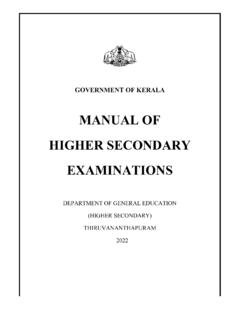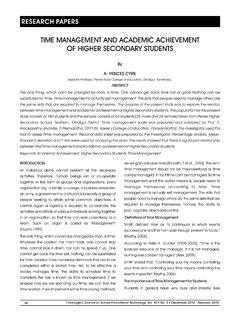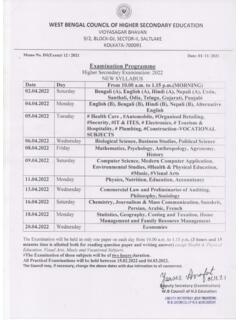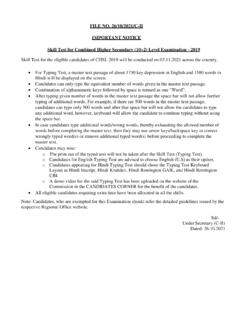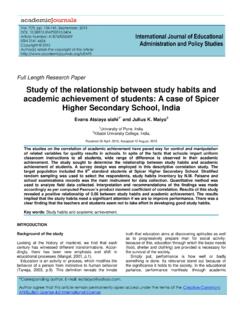Transcription of Informatics Practices - NCERT
1 Informatics Practices Syllabus for higher secondary Stage (Class XI and XII). Department of Education in Science and Mathematics (DESM). National Council of Educational Research and Training Aurobindo Marg, New Delhi - 110 016. Page | 1. Syllabus of Informatics Practices higher secondary Stage (Class XI and XII). Rationale: In the present education system of our country, specialised, discipline based courses are introduced at the higher secondary stage. This stage is crucial and as well as challenging because of the transition from general to discipline-based curriculum and the pressure to perform better to get admission to desired higher course.
2 National Curriculum Framework (NCF) 2005 recommends syllabus at this stage to have sufficient rigour and depth while being appropriate to the comprehension level of learners and at the same time not to be heavily loaded with contents. Informatics Practices (IP) is offered as an elective subject at the higher secondary stage of school education. At this stage, students take up IP with the aim of pursuing their interest and further study in computer application development and data science at higher levels. Courses offered till the secondary stage by the name of Computer Science (CS)/Information Technology (IT)/Information and Communication Technology (ICT) by various boards and schools up to secondary stage are also optional and largely focus on teaching office automation tools and other application software.
3 Therefore, at higher secondary stage, for learners without background knowledge of computer science, there is a need to introduce the basics of Computer as well as the importance of data science in today's scenario. Covering up the sufficient conceptual background of Informatics is required to make learners competent to meet the challenges of academic and professional courses after the higher secondary stage. Informatics is concerned with the study of Information Systems designed for creating, recording, storing, processing and communicating information. By utilizing the power of Information Technology, we can extract knowledge from data and information, which is otherwise difficult to visualise.
4 In a data driven world, Informatics plays key role in the way we live, work and think. The syllabus of Informatics Practices attempts to start with how do computers work and traverse through the fundamentals of programming and then focus mainly on the role of data and the importance of handling and interpreting meaning out of data. Emphasis is given to the representation of data, their processing, searching through queries and visualization. The syllabus has been developed based on the following broad areas which have been further classified into chapters: Page | 2.
5 Fundamentals of computers: Brief introduction to a computer system including functional components, memory, role and type of software. The idea is to create awareness about the emerging trends in IT and IT enabled applications and services. Programming: The basic constructs of a structured programming approach that includes program structure, identifiers, variables, control structure. Python data structures lists, dictionaries and their handling are discussed. The aim is to empower learners to be confident of writing programs and small application projects.
6 Database Management: An introduction to Data, Database and its purpose, trends of data driven decision making in key areas are highlighted. The collection and storage of data in a file system as well as database system are compared. Introduction to relational data model, RDBMS, and programming using Structured Query Language (SQL) are covered to enable learners to create, manipulate and query a database. Data Handling: The Python library for numeric data handling and analysis called Numpy is introduced. Analyzing data through basic statistics and its interpretation are covered briefly.
7 Two other Python libraries called Pandas and Matplotlib are used to introduce methods of data processing and visualization. Internet and Web: An introduction to Internet, World Wide Web and its structure are covered to give an overview about the ICT. Brief overview of web browser, websites, webpages, as well as web server and web publishing are included. Societal Impact of IT: The societal challenges that are arising along with the expansion in usage of technology are highlighted here. How to be safe and secure while browsing and communicating online as well as the importance of social, ethical values, and soft skills are highlighted.
8 The rising issues such as of cyber bullying, cyber crime and hacking are discussed to empower the learner to safeguard themselves and their peers. Issues like copyright, plagiarism, IPR, along with their ethical and legal aspects are explained. Environmental and health concerns of usage of digital devices are included to enable learners to make informed decisions while using technology. Page | 3. After the completion of the two years course student will be able to: identify the functional components of a computer system;. identify the emerging trends in the field of computer and information technology and elaborate how they influence modern society.
9 Distinguish between proprietary and open source software;. understand the importance of data in discovering interesting knowledge;. recognise the importance of storing data for subsequent use;. understand concepts of data management and relational DBMS and its need;. create a relational database using MySQL. use SQL to search data from a database in different manners;. aggregate, analyze data using Python Data vectors and Frames;. visualizing and plotting of data for better understanding of data and plot data;. develop some idea about how the Internet and Web works.
10 Recognize the impact of Information Technology on Society and the precautions to be taken in a digital world. Page | 4. Course Outline for Class XI. Total Periods 180 (including practical periods). Chapter 1: Computer System 10 Periods Introduction to computer and computing: evolution of computing devices, functional components of a computer system and their interconnections, I/O devices. Computer Memory: Units of memory, types of memory primary and secondary ; data deletion, its recovery and related security concerns. Software: purpose and types system and application software, generic and specific purpose software.










